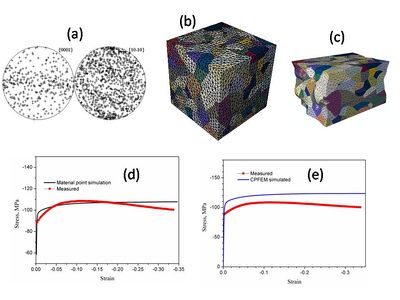Integrated Computational Materials Engineering (ICME)
A channel die compression simulation on Mg AM30
Abstract
Deformation of polycrystalline aggregates of HCP crystals was investigated
by employing crystal plasticity and finite element simulations. Results were
validated using channel die compression tests. The three dimensional
polycrystal, represented by Voronoi techniques, was assigned an initial
distribution of crystallographic orientations determined from X-Ray
Diffraction. The mechanical properties from the channel die compression tests
were used to correlate the material parameters of the crystal plasticity model.
Simulations predicted grain-to-grain interactions and the resulting texture
evolution under channel die compression. The inhomogeneous deformation among
grains was mapped by a stress and a strain distribution and grain orientation
spread. The simulation results were compared with experimental observations of
an HCP polycrystal subjected to channel die compression.
Author(s): Q. Ma, E.B. Marin, A. Antonyraj, Y. Hammi, H. El Kadiri, P.T. Wang
and M.F. Horstemeyer
Methodology
Magnesium has a hexagonal close-packed (HCP) structure whose deformation
modes are different from those of aluminum. Typical deformation modes in
magnesium are basal <a>-{0002}<11-20> slip, prismatic <a>-{10-10}<11-20&gr; slip,
second pyramidal <c+a>-{11-22}<11-23> slip and extension twinning
{10-12}<10-11>. In this study, a commercial extruded AM30 alloy (mass %, 2.54%
Al, 0.40% Mn, Mg in balance) was selected as the HCP experimental material to
conduct channel die compression at high temperature 200C and at strain rate of
0.001/S to strain 30%. At these loading conditions, twinning would not be
profuse and, hence, only slip will be the predominant deformation mode. The
hardening parameters of the three slips modes were obtained using material
point simulations to fit the experimental stress-strain curve recorded from the
channel die compression test as shown in Figure 1d.
The texture of AM30 was measured by X-ray diffraction method (XRD). The
recalculated pole figures were calculated based on the orientation distribution
functions (ODFs) which was obtained using the measured six incomplete pole
figures {10-10}, {0002}, {10-11},{10-12}, {11-20} and {10-13}. The initial and
the channel die compressed texture of AM30 plotted by the texture software MTEX
[1].
The commercial finite element software ABAQUS 6.9 and a user subroutine UMAT
incorporating the crystal plasticity constitutive theory and the magnesium AM30
materials parameters were used to simulate texture evolution and mechanical
response. The initial texture used in this CPFEM simulation was measured in the
undeformed sample and was represented by 343 discrete orientations as shown in
Figure 1a. The 3D polycrystal is represented by the 3D Voronoi grains created
by the code Neper [2]. The undeformed polycrystal and the channel die
compressed 3D polycrystal up to a strain of 30% are presented in Figures 1b and
1c.The simulated and measured channel die compression stress-strain curves are
presented in Figure 1e.

Figure 1. (a)Initial texture; (b) undeformation 3D Voronoi structure; (c)channel die compressed 3D Voronoi grains; (d) materials point simulated and measured stress-strain curves and (e) crystal plasticity and 3D structure predicted and measurd stress-strain curves.
Material Model
VPSC: ViscoPlastic Self-Consistent
Input Data
See VPSC Input Deck for a channel die compression simulation on Mg AM30
Results
Plane strain compression simulations of a three dimensional microstructure of HCP magnesium AM30 were performed using an elastic-plastic crystal plasticity model and the finite element method. The mechanical response, global texture evolution and the intergranular heterogeneous plasticity of discrete grain were captured by the 3D Voronoi microstructure channel die compression simulation. Simulation results showed that the effect of grain interaction could play an important role on global texture evolution, the orientation spread and the local heterogeneity deformation of one grain.
Acknowledgments
The authors are grateful to the financial support from the Department of Energy, Contract No. DE-FC-26-06NT42755, and the Center for Advanced Vehicular Systems (CAVS) at Mississippi State University.
References
Antonyraj, A., Marin, E., Ma, Q., Wang, P., Horstemeyer, M., & King, R. (Oct
2010). Re-Crystallization Studies of a Channel-Die Compressed AM30 Magnesium
Alloy. TMS 2011, California.
Ma, Q., Marin, E., Antonyraj, A., Hammi, Y., Wang, P., & Horstemeyer, M. (Oct
2010). On Predicting the Channel Die Compression Behavior of HCP Magnesium AM30
Using Crystal Plasticity FEM. Magnesium Technology 2011, 583-587. Proceddings
of 2011 TMS Annual Meeting and Exhibition, San Diego, California, USA.
